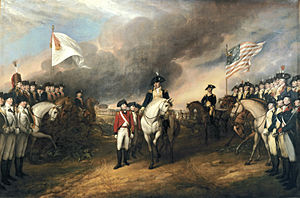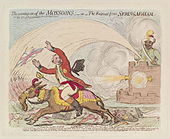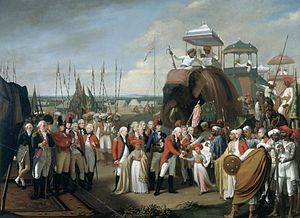We suspect most of our readers have watched the film “Patriot” starring Mel Gibson. That film ends with the surrender of British General Cornwallis in 1781 at Yorktown & the birth of The United States of America. Very little is known in America about what Cornwallis did after his surrender. And it is generally believed that the end of Britain’s rule in North America was the beginning of the end of Britain as a dominant world power.
 (Cornwallis – Surrender at Yorktown – courtesy Wikipedia)
(Cornwallis – Surrender at Yorktown – courtesy Wikipedia)
Actually not. His surrender at Yorktown was actually the beginning of the real career of Cornwallis & that was also the beginning of Britain’s rise to the empire on whom that sun never set. The stage was set for Cornwallis to finally change the world.
1. The Turn in India & Britain
Just look at the World’s GDP in 1700.
 (courtesy – Geopolitical Futures)
(courtesy – Geopolitical Futures)
India was the largest economy & a major military power whom no one had defeated – not Alexander of Macedon, not the Huns & not the Muslim conquerors who rose to wipe out earlier Middle Eastern empires of Iran & Turkey in the 7th century. Alexander’s army was routed & he ran away in boats via the Indus river to Iran. The Huns were so badly massacred that it took them a long time to look back at India. The Arab Muslim armies who wiped out Iran were routed all the way into the end of that millenium.
But India began turning inwards around 900 CE while the Turkic tribes of Central Asia began growing in military tactics & power. The central rule in North India broke down into independent kingdoms. Then came the great Mohammed of Ghazni, the man who launched, in 998 CE, the Afghan-Uzbek era of plunder & conquest of first North India & with North Indian help the conquest & plunder of South India. This was also the period when China began outpacing India in the post Mongol era.
You see India’s share of World GDP fall between 1000-1500. It stabilized in the next century under the Timurid-Mongol rule. Then came the Independence movement of Marathi people from Central India that destroyed the Mughal rule, bankrupted the Mughal Treasury & literally buried the strongest & most diabolical Mughal ruler Muhi-uddin Mohammed (self-proclaimed as Aurang-Zeb – Jewel of the throne) in a 27 year war.
Then, just as Cornwallis-led British were fighting to survive in North America, the Marathi Confederacy suffered three disastrous blows.
- The first was the disastrous self-inflicted defeat in 1761 at Panipat in the war against the Durani empire of Afghanistan. Had the Marathi army won that war, they would have wiped out the fledgling coastal outposts of the British in Calcutta on the Northwestern coast of India. After all, they had already wiped out the Portuguese from the eastern coast of India.
- The next several years were devoted to rebuilding & reconquering Delhi in North India when Madhav-Rao Peshva, the young Marathi ruler passed away at the age of 32 leading British “historian” Grant Duff to write “And the plains of Panipat were not more fatal to the Maratha Empire than the early end of this excellent prince…”
- The final blow was the end of Mahadaji Shinde, the great Maratha General & Trustee of Marathi regime in North India, around the time Cornwallis was hired into the British outpost in Calcutta, India in 1786.
(Cornwallis mocked in 1792) (Cornwallis accepting sons of Tippu as hostage in 1793)
Cornwallis did not have it easy. The British political cartoon (left above) mocks his retreat in 1792 from a town in South India. He then worked with the geostrategically ignorant Marathi rulers & sought their help to defeat Tippu Sultan, the Muslim ruler in South eastern India. After the defeat of Tippu Sultan, the British were able to encircle the gasping Marathi regime & eventually end its rule in 1818.
2. Fall of India, Fall of China & Rise of Britain
Look at the World GDP chart above and note the year 1820. That was the year Britain gained control of all of India. Their plunder of India was methodical, brutal & horribly racist to use a modern word.
Don’t just focus on India. Focus actually on the precipitous fall in China’s share of world GDP from 1820 to 1950. China, as giant with 33% of World’s GDP (like USA after WWII), saw its share fall to less than 5% of World’s GDP in 1950.
What made that happen? India, or British control of India. As George Friedman, founder of Geopolitical Futures & ex-founder of Stratfor, wrote this week in his article The People’s Republic of China at 70: Of Opium and 5G:
- “In the mid-19th century, British merchants approached China, as they approached most of the rest of the world. When they arrived in the 1840s, China was the largest economy in the world. … It was inevitable that British industrialism and mercantilism and Chinese pre-industrialism and mercantilism would meet, and meet violently.”
What weapon worked best for the British? And where did they get that weapon? Friedman explains:
- “The British wanted to sell more than just industrial products to China; they wanted to sell opium. The British were coming to dominate India, which had vast amounts of opium. The drug was banned by the Qing Dynasty that ruled China, so the British smuggled opium into China, first covertly and then by force of arms. The opium destroyed many lives in China, as it did in all countries, while the British made vast amounts of money from the trade. As they discovered China, they discovered potential markets for many goods and labor to produce them. They demanded that areas like Hong Kong be ceded to British rule to protect their economic interests. The Qing Dynasty, weakened by the British, had no choice but to concede. Over time the British were joined by the French, Germans, Japanese and Americans, among others.”
The British also “stole” tea from China & began growing it in Assam, the northeastern corner of India thus destroying Chinese monopoly on the export of tea.
3. What made Britain Great? Is History Repeating with America?
Look how Jacob Shapiro of Geopolitical Futures describes the state of Britain in 1800:
- “Revolutionaries kicked the British out of what would become the United States and so deprived the throne of its most valuable colonies in the New World. Failed attempts to maintain the empire caused British debt to skyrocket, reaching nearly 200 percent of gross domestic product by 1800. Just across the English Channel, a more populous and wealthier French challenger appeared primed for Eurasian domination, blessed as it was by Napoleon’s military prowess.”
Wrong. Britain was just beginning to be Great. As Shapiro writes,
- “There were several reasons for this reversal of fate, but the most important was well-known to British politicians themselves at the time. In the words of Lord Curzon in 1901, “As long as we rule India we are the greatest power in the world. If we lose it, we shall drop straight away to a third-rate power.” Britain withstood Napoleon, the loss of the American colonies, the Qing Dynasty, and its surging debt because it conquered Mughal India, an almost century’s long process that culminated in a two-year war and the application of direct rule of the British Raj in 1858. In many ways, India gave Britain a sustained period of global hegemony.“
This article is NOT a history lesson. It is the direct result of the Trump-Modi hand-in-hand victory lap in Houston on September 23, 2019:
And what came a mere week later? The below in the biggest ever military parade to celebrate New China at 70:
Go back above to read again what Shapiro wrote – “in many ways India gave Britain a sustained period of global hegemony“. Now read what Shapiro wrote on September 27, 2019 in his article India’s Fate Is in Its Own Hands:
- “Today, the United States believes India will do the same for it. The U.S. doesn’t intend to conquer India by force, of course. … No, Washington wants to coax India to abandon its history of non-alignment in foreign policy and throw in its lot with a U.S.-led future.”
- “And if there is to be a U.S.-led future, Washington has little choice but to court India. Having identified China and Russia as strategic rivals and having committed itself to containing both Iran and North Korea, the U.S. needs an ally with India’s potential economic, political and military heft. Indeed, there is no country in the world that can come close to easing the immense foreign policy burden the U.S. carries more than India. For the United States to achieve its foreign policy goals while still maintaining its global primacy, it needs to enlist India’s support as a ready and willing ally.”
It is not clear that this US-India dialog will succeed. The memories of Britain are still fresh in India. On the hand, an aggressive China provides the counter-pressure. We will discuss the various issues involved in a later article.
BUT suffice it to say that a US-India partnership will NOT happen without President Trump & Prime Minister Modi. Not just India. Electing President Warren or President Biden will simply force all of Asia & the Middle East to turn away from America in disgust. That is the real message of the enormously successful & ground-breaking Trump-Modi public summit in Houston.
Send your feedback to [email protected] Or @MacroViewpoints on Twitter

